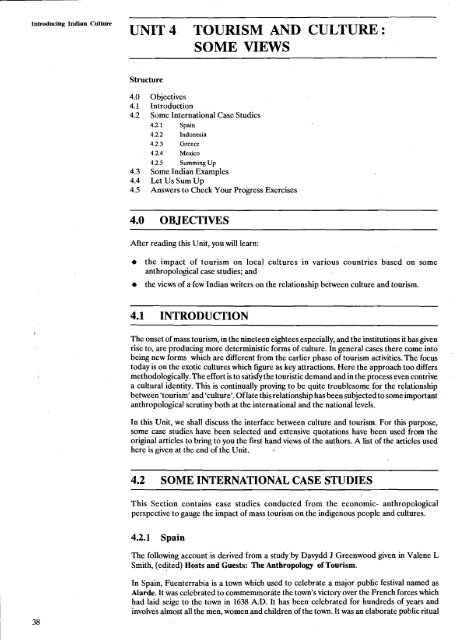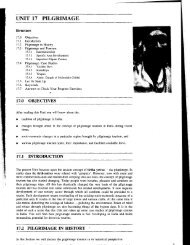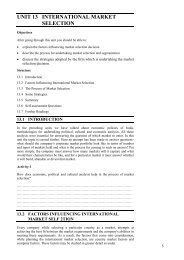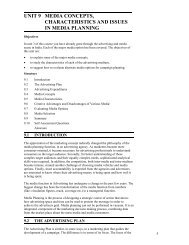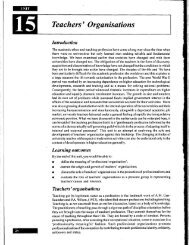UNIT 4 TOURISM AND CULTURE : SOME VIEWS - eGyanKosh
UNIT 4 TOURISM AND CULTURE : SOME VIEWS - eGyanKosh
UNIT 4 TOURISM AND CULTURE : SOME VIEWS - eGyanKosh
Create successful ePaper yourself
Turn your PDF publications into a flip-book with our unique Google optimized e-Paper software.
Introducing Indian Culture<br />
<strong>UNIT</strong> 4 <strong>TOURISM</strong> <strong>AND</strong> <strong>CULTURE</strong> :<br />
<strong>SOME</strong> <strong>VIEWS</strong><br />
Structure<br />
4.0 Objectives<br />
4.1 Introduction<br />
4.2 Some International Case Studies<br />
4.2.1 Spain<br />
4.2.2 Indonesia<br />
4.2.3 Greece<br />
4.2.4 Mexico<br />
4.2.5 Summing Up<br />
4.3 Some Indian Examples<br />
4.4 Let Us Sum Up<br />
4.5 Answers to Check Your Progress Exercises<br />
4.0 OBJECTIVES<br />
After reading this Unit, you will learn:<br />
the impact of tourism on local cultures in various countries based on some<br />
anthropological case studies; and<br />
the views of a few Indian writers on the relationship between culture and tourism.<br />
4.1 INTRODUCTION<br />
The onset of mass tourism, in the nineteen eightees especially, and the institutions it has given<br />
rise to, are producing more deterministic forms of culture. In general cases there come into<br />
being new forms which are different from the earlier phase of tourism activities. The focus<br />
today is on the exotic cultures which figure as key attractions. Here the approach too differs<br />
methodologically. The effort is to satisfy the touristic demand and in the process even contrive<br />
a cultural identity. This is continually proving to be quite troublesome for the relationship<br />
between 'tourism' and 'culture'. Of late this relationship has been subjected to some important<br />
anthropological scrutiny both at the international and the national levels.<br />
In this Unit, we shall discuss the interface between culture and tourism. For this purpose,<br />
some case studies have been selected and extensive quotations have been used from the<br />
original articles to bring to you the fist hand views of the authors. A list of the articles used<br />
here is given at the end of the Unit.<br />
4.2 <strong>SOME</strong> INTERNATIONAL CASE STUDIES<br />
This Section contains case studies conducted from the economic- anthropological<br />
perspective to gauge the impact of mass tourism on the indigenous people and cultures.<br />
4.2.1 Spain<br />
The following account is derived from a study by Davydd J Greenwood given in Valene L<br />
Smith, (edited) Hosts and Guests: The Anthropology of Tourism.<br />
In Spain, Fuenterrabia is a town which used to celebrate a major public festival named as<br />
Alarde. It was celebrated to comrnemmorate the town's victory over the French forces which<br />
had laid seige to the town in 1638 A.D. It has been celebrated for hundreds of years and<br />
involves almost all the men, women and children of the town. It was an elaborate public ritual
in which the was voluntary and general. But while the entire town participated<br />
in it, its symbols, rituals and meanings did not usually relate to the outsiders.<br />
In 1989, the Spanish government threw the Alarde open to the tourists in an attempt to create<br />
an added tourist attraction and insisted that "the Alarde should be given twice in the same<br />
day to allow everyone to see it." This move, in the words of the author, caused "a great<br />
consternation among the people of Fuenterrabia and a vaulting sense of discomfort. Soon<br />
this became the mask of cynicism that prefaces their attitudes toward the motives behind all<br />
business ventures in Fuenterrabia. Little was said publicly about it. But two summers later, I<br />
found that the town was having a great deal of difficulty in getting the participants to appear<br />
for the Alarde. No one actively or ideologically resisted, but in an event that depends entirely<br />
on voluntary compliance, the general lack of interest created serious organizational problems.<br />
In the space of two years, what was a vital and exciting ritual had become an obligation to be<br />
avoided. Recently the municipal government was considering payments to people for their<br />
participation in the Alarde. I do not doubt that they ultimately will have to pay them, just as<br />
the gypsies are paid to dance and sing and the symphony orchestra is paid to make music.<br />
The ritual has become a performance for money. The meaning is gone."<br />
This was a turning point for this festival and the intervention by the outsiders stripped the<br />
ritual of whatever meaning it held for the local people. We are reproducing below the<br />
conclusioa of the author :<br />
"As an analytical perspective has finally begun to develop with regard to the socioeconomic<br />
effects of mass tourism, it has become obvious that the increasing maldistribution of wealth<br />
and resultant social stratification are widespread results of touristic development. Various<br />
remedies are proposed as an attempt to counteract these problems. While these problems<br />
are serious and must be remedied, 1 am terribly concerned that the question of cultural<br />
commoditization involved in ethnic tourism has been blithely ignored, except for anecdotal<br />
accounts. The massive alterations in the distribution.of wealth and power that are brought<br />
.about by tourism are paralleled by equallymassive and perhaps equally destructive alterations<br />
in local culture.<br />
"The culture brokers have appropriated facets of a life-style into the tourism package to help<br />
sales in the competitive market. This sets in motion a process of its own for which no one,<br />
not even planners, seems to feel in the least responsible. Treating culture as a natural<br />
resource or a commodity over which tourists have rights is not simply perverse, it is a violation<br />
of the peoples' cultural rights. While some aspects of culture have wider ramifications than<br />
others, what must be remembered is that culute in its very essence is something that people<br />
believe in implicitly. By making it part of the tourism package, it is turned into an explicit<br />
and paid performance and no longer can be believed in the way it was before. Thus,<br />
commodization of culture in effect robs people of the very meanings by which they organize<br />
their lives."<br />
He further adds :<br />
"Perhaps this is the final logic of the capitalist development of which tourism is an ideal<br />
example. The commoditization process does not stop with land, labor, and capital but<br />
ultimately includes the history, ethnic identity and culture of the peoples of the world.<br />
Tourism simply packages the cultural realities of a people for sale along with their other<br />
resources. We know that no people anywhere can live without the meanings culture provides;<br />
thus tourism is forcing unprecedented cultural change on people already reeling from the<br />
blows of industrialization, urbanization, and inflation. The loss of meaning through cultural<br />
commoditization is a problem atleast as serious as the unequal distribution of wealth that<br />
results from tourist development."<br />
4.2.2 Indonesia<br />
In today's Indonesia there are two tourist places which are very important cultural<br />
destinations for the foreign tourists. These places are Toraja and Bali. Studies by Eric Crystal<br />
and Philip Frick McKean are used in this section extensively.<br />
In Indonesia, the international mass tourism started in the late 1960s but rapidly picked up<br />
and by the mid 1970s, Indonesia had become an important tourist resort. While many tourists<br />
visited the country to enjoy its coastlines and beaches, its importance as a cultural destination<br />
is very marked awing to its rich, varied and syncretic traditions. In Indonesia, the fusion of<br />
Culture and Tourism:<br />
Some views
Introducing Indian Cult= cultures exists in its richness and variety. Bali and 'Toraja are two of the most important places<br />
of tourist attraction. Tourists from many countries flock to these places to view the local<br />
festivals, rituds, ceremonies, dances, traditional arts and crafts and historical monuments.<br />
Initially, the influx of the tourists did not have much negative effects. But, with the passage of<br />
time and the increase in the number of tourists, many problems started emerging. In Toraja,<br />
the increase in the touribt traffic was sudden and the results more alarming. Basing on his<br />
study in 1976, Eric Crystal points out :<br />
"Tana Toraja may be unzque, and worthy of on-going careful study, because of the dramatic<br />
change within two years. The area has passed directly from the obscurity of elite, ethnic<br />
tourism to hecome a target for cultural, charter tourism without passing through any of the<br />
intermediary stages. It is too soon to fully assess the touristic impact, but some trends are<br />
evident. 'The local T'orajas are bewildered, and uncertain as to the choices open to them, or<br />
iheir outcome :<br />
I) If they open their villages, and their ceremonies, to tourism for the sake of economic gain,<br />
they are victimized by the compromise of cultural integrity;<br />
2) If they exclude the tourists, they are victimized by the inflation accompanying the influx,<br />
and enterprising neighbors reap the profits. Cultural conservatism does not 'pay'. During<br />
the tourist season of 1976 it was evident that rituals were being commercialized as<br />
'spectacles' for the foreigners, including being rescheduled at the request of foreign<br />
guides. Further, the disappearance of antiquities into the souvenir market indicated<br />
another potential cultural loss. My cautious optimism based on the 1974 data is strained,<br />
and further field research is needed. If, as anthropologists, WE have the capacity to guide,<br />
our skills should be applied here and now lest this fragile mountain community, which<br />
has o~lly its cultllral traditions to attract tourism, !oses both its heritage and the to~rists."<br />
On his subsequent visits to the area, the author recorded that while in 1975, the number of<br />
tourists to Toraja was only about 2500, by 1985 the number had increased to almost 40,000.<br />
This led to many changes. It has benefitted the people of the area in following ways :<br />
i) It has generated thousands of jobs for the locals and the infrastructural facilities in terms<br />
of roads and airstrips.<br />
ii) The economic and socio-political isolation of the region has now ended and the Torajan<br />
Culture, "once spoken of in derogatory terms, is now featured nationally in Indonesia as<br />
a major and important component of multicultural Indonesia."<br />
ui) The traditional Toraja crafts of weaving, ikat dyeing and he;idvr.cark haw found new and<br />
rich buyers and this has led to an improvement in the skills.<br />
These are some of the positive effects brc~ught about by the growth of tourism. But the<br />
traditional culture, life-styles and monuments have been victims of an unrestricted tourist<br />
growth. Eric Crystal says:<br />
"One of the sadder conseiuences of change in Toraja has bezn the accelerated loss of these<br />
precious heirlooms and cultural artifacts. Thert: is no doubt that tourism has played a<br />
significant role in this process. In 1969 beautiful strands of ancient beads were sold in each<br />
Toraja market by itinerant vendors. By 1976 villagers in the marketplace and the vendors<br />
themselves reported that such old beads were becoming increasingly scarce due to demand<br />
by visiting French tourists. By 1983 such beads were 'effectively' gone in the sense that they<br />
were out of the price range of the average village consumer. Tourists and itinerant<br />
international art dealers have demonstrated an insatiable appetite for old pieces of Toraja<br />
folk art. Newly crafted house panels, baskets, textiles, or carvings do not satisfy these most<br />
particular appetites; only the oldest, most weathered acd most exotic-looking pieces will do<br />
"Most devastating to the people of Toraja is the rape of ancestral statuary that continue<br />
unabated at this writing. The carving of ancestral images is common in a numher of relative1<br />
isolated cuiture regions of Indonesia and, indeed, was highly developed in many parts of th<br />
ancient world. Tau tau, or funerary statues, in Tana Toraja are carved of extremely durable<br />
jackfruit wood. Only the largest death ceremonies are embellished with a near life-sized<br />
wooden image of the deceased. After interment of the deceased in a limestone cave vault,<br />
the statue is placed in a gallery near the burial site. In 1969, two years before the first<br />
depredations were recorded, Tana Toraja preserved literally thousands of such statues in<br />
burial sites spread over much of its 3000 square kilometers of territory. When my fvst article
was written in 1975 I did not realize that the first highly selective raids on Toraja statuary were<br />
already taking place. By 1985 Toraja tau tau were bringing USS6000 sale prices in Los<br />
hgeles. During the past years agents with MOmm telephoto lenses have been dispatched<br />
from Western Europe to compose albums of 'available' statuary from which potential<br />
customers could select their desired piece. Working in league with local Toraja thieves,<br />
toreign agents spirited the statues from Tana Toraja, and transshipped them by air and sea<br />
tromDen Pasar, Bali, to overseas destinations. So sacred are these statues within Tana Toraja<br />
that no one would dare to openly sell such artifacts within the region itself."<br />
'The other tourist destination in Indonesia, Bali, about which we made a mention at the<br />
beginning of this section, has been studied by Philip Frick McKem. He finds that the many<br />
negative effects of tourist influx which are very noticeable in Toraja have not occurred in Bali.<br />
His explanation is that the Balinese people have escaped this due to a process called "cultural<br />
~nvolution". He explains this phenomenon in the following words:<br />
'An ironic theme permeates this analysis : modernization in Bali is occuring; tourism<br />
introduces new ideas and is a major source of funds. Yet, the tourists expect the perpetuation<br />
of ancient traditions, especially in the performing and plastic arts, and would not visit in such<br />
numbers if Baliwere to become a thoroughly modern island. Both consewatioa and economic<br />
necessity encourage the Balinese to maintain their skills as carvers, musicians, and dancers<br />
in order to have the funds for modernization."<br />
The resilience of the Balinese culture and the strength of its artisan traditions have withstood<br />
the impad of cultural invasion normally associated with mass tourism. The local people havk<br />
achieved it by separating the realms of tourism and their own spiritual and social identity and<br />
rendering unto each what is its own. As the author explores:<br />
"In Bali the rush toward standardization and simplification of the souvenir arts exists without<br />
the total loss of either functional fine arts or commercial fine arts, because indigenous<br />
institutions continue to demand high quality craftsmanship as appropriate offerings for the<br />
'divine world'. Balinese could ignore this mandate only at personal and corporate peril In<br />
Balinese ethos, to offer inferior gifts to the divine powers, and incur their displeasure, would<br />
be silly and shortsighted. It is one thing to sell inferior goods to tourists who do not know or<br />
care about artistic expqrtise, but to shortchange the infinitely superior taste of the spirit realm<br />
would be foolhardy indeed. Thus, Balinese craftsmen remain responsive to the marketplace<br />
in their willingness to alter the themes of their carvings from wayang (shadow puppet) figures<br />
to animal figures - and even to busts of Sophia Loren and Raquel Welch - and also responsive<br />
to the 'market' of the 'divine world' whose tastes and expectations are believed to remain<br />
infinitely more exquisite. Graburn reported that in other non-Balinese cases, craftsmanship<br />
has suffered a loss in quality, because the quality of the spiritual realm evidently suffered from<br />
degradation, and the spiritual 'audience' was no longer significantly viable. This is not true in '<br />
Bdi, at least not yet."<br />
But the author says by way of caution:<br />
"Certainly there are dangers for the Balinese in embracing tourism, and as in Toraja, the<br />
misuse of scarce resources, increased stratification with the 'rich getting richer', or<br />
environmental and ritual erosion may be so damaging to the indigenous way of Iife that<br />
tourism could eventually be evaluated by both social scientists and local villager as a profound<br />
and disastrous blight. The results will depend to considerable degree on actions within the<br />
political structures."<br />
4.2.3 Greece<br />
E. Wickens studies a village in Greece which has been providing "services" to both, the<br />
domestic and foreign tourists who come in search of "sun, sea and sand. The participati"on<br />
of the villagers in this quest has been almost total. They have willingly made available all the<br />
facilities and created ambiences which various types ~f tourists may desire.<br />
To start with, the name of the village was changed from Kapsochora (meaning a 'burning<br />
place') to Pefkochori (meaning 'pinewoods'), "a name thought to be more appropriate to its<br />
scenic location and therefore more attractive to tourists."<br />
Cdl&e and Tourism:<br />
Some views
Introducing Indian Culture Secondly, a local colour is sought to be given by serving local cuisines, traditional dances or,<br />
for that matter, whatever was thought to be enjoyable to that variety of tourist out to seek an<br />
encounter with the local culture. The author comments :<br />
"Intended mainly for foreign consumption, the taverna evcning is transformed from a<br />
mundanc social event into a spectacle, designed to make the evening exciting and memorable<br />
for the tourist. The taverna serves a hybrid cuisine - the traditional mezedes (a variety of<br />
salads and appetisers) bcing structured into a Western-style three-course meal with everyonc<br />
having the same. The meal itself is a combination of Greek and Western European dishes.<br />
'The rationale for the standardization of the content of these meals is that it allows for the<br />
efficient processing of large numbers of coach parties, is. a taverna can predict the number<br />
of meals it needs to prepare and so maximise its profit.<br />
"In addition, it offers staged performances of Greek traditional dances, which have been<br />
hybridised, i.e. simplified and modernised, especially for tourists. For example the kbasapiko<br />
(a butcher's dance), and its popularizedversion the syrtaki, and the zembetico (a man's solo<br />
dance expressing a mood of melancholy and suffering) are mass-produced, to be consumed<br />
by the tourists, just like any other product. These hybrid Greek dances are performed by a<br />
small group of men and women, dressed in traditional native costumes. These groups are<br />
instructed to encourage tourists to participate in these dances, which end with the traditional<br />
smashing of plaster plates. The sound of bouzouki music played in the taverna has also been<br />
modified, in order to appeal to the tastes of Western European visitors. Tourists thkn<br />
consume what I call a 'hybridplayful experience' of a traditional evening entertainment which<br />
has bcen modified to appeal to the international consumer.<br />
"What is quite apparent about these type of pseudo-events is that they appeal to foreign<br />
cash-customers. The 'expectation of pleasure' from a game of 'going native' seems to motivate<br />
particularly 'the touristic consciousness' of the Cultural Heritage, the Lord Byron and the<br />
Heliolatrous visitors. They are willing to play this game of being a tourist by day and a native<br />
by night, because it is fun and exciting. At the same time, thcy are aware that these sites and<br />
performances are staged, and that what they are consuming is not authentic but rather, a<br />
hybrid product."<br />
In addition to this "staged authenticity", we find that the western-style comforts are also<br />
provided to those tourists who do not want to abandon their familiar home ambience and );st<br />
want to enjoy their holidays, in a foreign land.<br />
The eEonomic benefits derived from the tourist influx have induced the locals to stretch over<br />
backwards to satisfy.al1 the needs and wants of the various kinds of foreign tourists. The<br />
consequences of this has been disastrous for the local cultural tradition, although the local<br />
people are quite unmindful of these effects in their pursuit of wealth. In the words of the<br />
author:<br />
"What has emerged in Pefkochori is a hybrid culture which neither reflects the normal culture<br />
of tourists, nor the traditional culture of a Greek village. It is a cross between a heritage<br />
museum and a pleasure-seeker's paradise. ...<br />
"In Pefkochori the concentrated presence of tourists over a 20- year period has led to the<br />
assimilation of the hedonistic consumer-oriented behaviour of tourists into the behaviour and<br />
value system of the local inhabitants. Pefkochori is a paradigm- case of a farminglfishmg<br />
community which has been undergoing a process of cultural hybridisation, of loss of<br />
traditional cultural identity. This hybridisation has lcd to changes in the,attitudes, values and<br />
the behaviour of the indigenous population, particularly that of the younger generation. It is<br />
.=<br />
in effect, a process of 'acculturation'."<br />
4.2.4 Mexico<br />
G Evan's study of coastal tourism in Mexico is focussed around a very important issue : the<br />
erosion of the culture, life-styles and values of the indigenous Red Indian communities due<br />
largely to the promotion of state-sponsored mass tourism. The state is controlled by the white<br />
communities who have little or no regard for the tradition and culture of the native Indian<br />
communities who were the original inhabitants of the land. The Spanish conquests and<br />
colonisation from 16th century onwards led to the extermination and marginalisation of the<br />
indigenous people. Their lands were confiscated in the rulers' quest for "modernisation",
Culture and Tourism:<br />
particularly during the 19th century. Their traditions andvalues were eroded and their history, Some views<br />
because it was-based on oral tradition and had no written records, was disregarded.<br />
The coming of mass tourism into the country during the 1950s and 1960s further intensified<br />
these trends. The Indian lands were confiscated for building hotels and developing tourist<br />
resorts. All the benefits derived from the tourist influx, however, went into the coffers of the<br />
outsiders who owned hotels and shops. The local people virtually have no control over the<br />
tourism business at any level. The suggestions made by the author in this case are given<br />
below:<br />
"The choice to participate in tourism should be available and where intermediaries are still<br />
desirable, economic benefits must be retained, not just locally, but by the generators<br />
('owners') of ethnic tourism, whether led by craft, performance or other visitor experience.<br />
"As a corollary, tour promotion by national and international operators can ensure greater<br />
pre-tour information and guide- training (especially of indigenous representatives),<br />
consistently throughout the tour-hospitality system.<br />
"The political and economic forces that will require both resistance and change, are<br />
substantial in the case of Mexico. Indigenous populations risk being overridden by economic<br />
imperatives and resource-exploitation, including mass and invasive tourism. The adaptation<br />
and survival of the Indian socio-cultures to date is all the more remarkable for this, and<br />
therefore tourism must learn from and mitigate these effects, and render meeting grounds<br />
places of mutual respect and experience."<br />
4.2.5 Summing Up<br />
In the foregoing account we have basically analysed four situations brought about by the<br />
interaction of the tourists with the local population.<br />
i)<br />
In case of Spain, faced with the tourist onslaught on their most cherished and popular<br />
festival, the Alarde, the people of Fuenterrabia withdrew and the festival lost its charm<br />
and meaning and became a purely staged event for the purpose of tourism.<br />
ii) In Indonesia, two tourist sites have been discussed. In the case of Toraja, we find that<br />
although the local people made and still make efforts to save their culture, they have, in<br />
effect, been completely swamped by the tourist invasion. They have defmitely derived<br />
economic benefits and socio- recognition; but they are very much in danger of<br />
losing their cultural identity and traditions.<br />
In Bali, however, the local culture has proved more resilient. It has saved itself by the<br />
process of "cultural involution" which has reinforced the tradition just because that is<br />
what the tourists like. Moreover, the Balinese people distinguish between the demands<br />
of the tourists and those of their gods and have institutionalised this separation by making<br />
different objects for the tourists (which may involve making of some compromises in their<br />
traditional arts and crafts) from what they make for their ritual offerings.<br />
iii) In the case of a village in Greece we see that the lure of money has been so overpowering<br />
that the local population is willingto compromise on all aspects of their culture and<br />
values. However, they have been the beneficiary of the economic boom brought about<br />
by tourism.<br />
k<br />
iv) The red Indians of Mexico have benefitted neither economically nor culturally by the<br />
tourist encounter. They have been the losers on all counts. In their case, it is a<br />
phenomenon of internal and external colonialism ushered in by the state-sponsored<br />
tourism. Their example can be true of many oppressed and marginalised communities<br />
in the third world countries.
lnlrodueidg Indian Cullure<br />
r<br />
Check Your Progress-1<br />
1) In what way has'tourism affected.the. local wmnnities in Toraja (Indonesia). and<br />
Pefkochori (Greeee) ? Write in 100v~ids.<br />
. > . . .<br />
: . a<br />
.....................................................<br />
,<br />
, ~ , - ,..<br />
.................................................<br />
2)<br />
Discuss "cultural involution" in the case of Bali. What significance can it have in India's<br />
case? ,<br />
3) What is the significance of the experience of the Mexican Indians ? Write your own<br />
suggestions in this regard.<br />
4.3 <strong>SOME</strong> INDGN EXQMFLES<br />
India is being promoted as a major tourisf destination by the planners and policy-makers. As<br />
a spokesman of the tourism industry would say, it has everything to offer - mourltains and<br />
seas, forests and wildlife, an ancient culture and modern facilities, avariety of festivals, fairs,<br />
dresses and costumes, aboriginal cave-age tribals and 21st century elite; you just name it and<br />
you have got it here.<br />
But human beings learn by experiences - of their own and of others. So before unrestricted<br />
and unmanaged tourism is given the green signal we must stop and critically examine its<br />
influences and repercussions, especially on our culture.<br />
To begin with, we can take the example of Kovalam in Kerala. The following account is based<br />
on a study by T G Jacob.<br />
About three decades ago Kovalam was a small coastal village growing coconuts and, on a<br />
small scale, catching fishes. The economy was mostly sustained by selling copra, oil aqd coir<br />
yarn products.
Culture and Tourism:<br />
The development of Kovalam as a tourist resort led to the construction of hotels and influx views<br />
of tourists whose number has now r~ached 65,000 per season. The arrival of the foreign<br />
tourists has caused an increase in the number of the domestic tourists also many of whom<br />
come just to observe the half-dressed or undressed white tourists on the beach.<br />
Prostitution - both female and male - has accompanied the tourists and so have the drugs.<br />
Many local youths can be seen on andaround the beach peddlingdrugs. Smack addiction has<br />
also risen among the youth as a result of this. The traditional occupations have declined and<br />
the land prices have increased phenomenonally, As a result the land ownership has shifted<br />
to the outsiders who mainly use the land for speculation and not for anything productive. This<br />
has pushed hundreds of families out of their traditional occupations. The benefits of tourism<br />
in terms of jobs and wealth have gone mostly to the outsiders and mostly the menial and<br />
low-paid jobs are left to the Kovdans. Many unemployed youths have found 'employment' in<br />
peddling the dwgs. The only traditional occupation thriving "under these circumstances is<br />
stone quarrying. Land that once provided a steady and continuous income from agriculture<br />
has been permanently lost to quarrying which gives quick and high returns. Deep, ugly pits<br />
scar the earth. With the growing demand for high quality Krishna shila stone, a large number<br />
of women and children, displaced from their agricultural occupations, now work in stone<br />
quarries, breaking rocks in scorching sun or rain. They are paid a pittance for their labour,<br />
as compared to agricultural wages. Their poverty, it would seem, is yet another sightseeing<br />
'attraction' for tourists."<br />
It, therefore, becomes quite clear that tourism is not such an unmixed bl&sding as it is bade<br />
out to be by many who plan and profit by it. The pursuit of money has led to degradation of<br />
culture and environment. It has not helped the local people much even in terms of their<br />
acquiring wealth by "serving" the tourists at various levels. A meaningful development of the<br />
traditional occupations and industries might probably have done more in terms of generating<br />
employment. In another study, A. G. Krishna Menon has addressed the problems and<br />
dilemma faced by cultural tourism in India today. We are reproducing extracts here :<br />
"The other part of the mindset is clearly evident in the obsession the policymakers display<br />
for increasing foreign exchange earnings through the promotion of tourism. All the pious<br />
concerns for 'socio-economic development' notwithstanding, the tourism policy of the<br />
government is almost entirely predicated on this criteria. Thus, we find in practice, tourism<br />
in India is more considerate to the welfare of the foreign tourist than the well-being of the<br />
local population. Not surprisingly therefore, there is increasing evidence is tourism<br />
literature that the general social and economic well-being of society deteriorates with<br />
increasing tourism. Effects of this phenomenon can also be gauged by the protest movements<br />
mounted by grass-root organisations, for instance, in Goa to actively campaign against<br />
tourism development. Thus, we are confronted with the great dilemma of cultural tourism<br />
in our country: the most abundant tourism resource may be unexploitable. Why is this so?<br />
There could be several readings of this situation but one reading concerns the right of the<br />
collective - the government - to arrogate to itself the power to exploit local cultures. This<br />
backlash of popular sentiment is, of course, part of a world-wide trend towards local<br />
self-expression and promotion of local cultural identities. Any policy which is perceived to<br />
threaten or compromise these local identities is fiercely resisted. Inevitably, cultural tourism<br />
is perceived to be such a threat by local societies."<br />
The author continues:<br />
"With this background, the position of culture in the process of cultural tourismcan beviewid<br />
as both protagonist and victim, at once so strong and pervasive as to have survived millennia<br />
and yet so vulnerable to encroaching alien forces unleashed through modern tourism. .The<br />
greater tragedy of this situation is that tourism in a developing society such as ours is-reavy<br />
the thin edge of the wedge of modernism. Indian society and culture need to deve)%aqd<br />
mdernise, and must indeed recancile with the forces of modernit>, -In the absence, of:qtkr<br />
development initiatives, tourism is often - in places 1ik~;Jaisalqc and Goa, Shib and q&y<br />
- the prime agent for economic, social and coltural change. .It becoxys a mgrter 9f great<br />
concern, therefare, i;f@wism were t~accqpaplisb thisad)ustmenthy transforming tbespqqe<br />
of '.Indianess' I herder to aWue .a~g dgg~g of 4 ~ s Obviously, ~ . there i,s qged &TF$i$<br />
i, tk pz~pmitian ind m&e,tbe::bp~r&w qfj &~al,~phg{es dqterae pvpneJefq of<br />
toutism-sltratagy4,rathr;r thasklk @her ~zg~aqggdas,& i$!&ne aPprqeni,. , *.; a ,; .- , ,, -<br />
, , .:Jk > ,... . . f., . ' ~, , .?x-!f!.:: :,;(I ,:< ;iji.*,.'?.i:l ,.:],,i-: ?,,i: -
In(roducing Indin of economic parameters such as the quantum of foreign exchange earned. Tourism policy<br />
must be developed with greater consideration for ground realities and its impact on local<br />
cultures. It needs to be formulated by interdisciplinary teams of social scientists - including<br />
economists and marketing strategists, rather than the present team of generalist<br />
administrators relying on 'foreign' expertise.<br />
"It is on account of such 'foreign' expertise that India's tourism policy reacts to foreign<br />
demand rather than cater to indigenous needs. It is 'demanded', and strategists seek to<br />
emulate 'foreign' models to meet this demand. The models they have in mind are such<br />
'successes' like the beach resorts of Bali or Thailand, and of course, Disneyland.<br />
Unfortunately, this overt bias to follow foreign models substitutes as tourism policy.<br />
"This process of servicing foreign needs on their terms recreates old colonial structures in the<br />
relationship between the visitor and the host community. ... Culturally loaded images are<br />
casually used in tourism promotion literature to entice foreign tourists: Rajasthan is 'martial',<br />
Khajuraho is 'romantic' and Goa is 'fun, frolic, festivals and fen?. The tragedy that such<br />
insensitivity can result in is evident in the state of the tourism industry of South East Asia - a<br />
'success' at a financial level, but an unmitigated disaster at the social and cultural level."<br />
r<br />
Check Your Progress-2<br />
1) How has tourism affected the life of the local people of Kovalam ?<br />
2) What is the basic dilemma faced by cultural tourism in India?<br />
4.4 LET US SUM UP<br />
The process of cultural exchange supposed to occur with the tourist interaction with the host<br />
communities has failed to take off. This failure is now being clearly recognised the world over.<br />
Reasons for this are many. Firstly, the lack of sufficient time at the disposal of the tourists<br />
hardly provides them the opportunity for an in-depth knowledge of the local culture. Nor can<br />
the locals interact with them fruitfully and understand them. Secondly, the economic<br />
consideration creates a misunderstanding. The locals may think that the tourist is a miser<br />
while the tourists may find the locals too greedy. Such a misunderstanding rules out any<br />
effective cultural interaction. Thirdly, the marketing of imitation cultural productsin the form<br />
of tourist- oriented staged festivals etc. effectively debars the tourists from the knowledge of<br />
genuine local cultures. The locals, in any case, have no means by which they can get to know<br />
the authentic culture of the tourists. Fourthly, the intervention of the middlemen at various<br />
levels creates barriers between the tourists and the locals. The lack of knowledge of each<br />
other's language also contributes to this.
Culture and Tourism:<br />
he more important thing now is to devise ways to save the local culture from the tourist Some views<br />
invasion. The resilience which many cultures display saves them from being overwhelmed by<br />
this mixed cross-cultural influences. But those which are more receptive very soon face the<br />
danger of gross distortion. In a country like India with dense population and varied cultures %<br />
the tourism cannot really solve the problem of unemployment and may instead create severe<br />
pressures at the social and cultural levels thereby increasing tension in many areas. The<br />
policymakers and planners, therefore, must be wary of uncritically and unrestrainedly<br />
extending tourism to all regions of the country. That is the only way by which the economic<br />
benefits can co-exist with cultural conservation.<br />
4.5 ANSWERS TO CHECK YOUR PROGRESS EXERCISES.<br />
n<br />
Check Your Progress-1<br />
1) See Sub-sec. 4.2.2 & 4.2.3.<br />
2) See Sub-sec. 4.2.2.<br />
3) See Sub-sec 4.2.4<br />
r<br />
Check Your Progress3<br />
1) See Sec. 4.3.<br />
2) See Sec. 4.3.<br />
wegratefully acknowledge our dtbt to the following authors and their articles :<br />
For our discussion on the Spanish town - Davydd J Greenwood, 'Culture by the Pound:<br />
An Anthropological Perspective Jn Tourism as Cultural Commoditization' in Hosts and<br />
Guests : The Anthropology of Tourism, edited by Valene L Smith, University of<br />
Pennsylvania Press, 1989.<br />
For the accounts of the Indonesian tourist resorts the following two articles from the<br />
Valene L Smith's (ed.) aforementioned book have been used: Eric Crystal, 'Tourism in<br />
Toraja (Sulawesi, Indonesia', and Philip Frick McKean, 'Towards a Theoretical Analysis<br />
of Tourism: Economic Dualism and Cultural Involution in Bali'.<br />
For an account of the impact of tourism on a Greek Village: E Wickens, 'Consumption<br />
of the Authentic : The Hedonistic Tourist in Greece' in Khan et.al.(ed.) VNR's<br />
Encyclopaedia on Hospitality and Tourism, New York, 1993.<br />
The discussion of the plight of the Mexican Indians by the colonial policies of the<br />
government and the touristic invasion has been taken from: G Evans, 'Whose Culture<br />
is it anyway ? Tourism in Greater Mexico and the Indigena'; in Khan et:al., ibid.<br />
The impact of tourism on the people of Kovalam in Kerala has been discussed by:<br />
T. G. Jacob, 'From Madrigal to Dirge - The Story of Kovalam' in The Eye, Vol. 11, No.4.<br />
For the other part of the discussion relating to cultural tourism in India in the Sec.4.3,<br />
we have quoted from: A G Krishna Menon, 'The Dilemma of Cultural Tourism in India',<br />
Tbe Eye, Vol. 11, No.4.<br />
Apart from these articles, the Valene L Smith's (edited) book and the relevant issue of the<br />
magazine The Eye can be very fruitfully scanned by those desirous to know more about the<br />
cultural interaction between the tourists and the hosts.
Introducing Indian Culture<br />
t<br />
i..<br />
<strong>SOME</strong> USEFUL BOOKS FOR THIS BLOCK<br />
A.L. Basham The Wonder that was India<br />
SAA. Rimi The Wonder that was India, Vol. I1<br />
Tara Chand Influence of Islam on Indian Culture<br />
Yu~f Husain Glimpses of Medieval Indian Culture<br />
ACTIVITIES FOR THIS BLOCK<br />
1) Make a list of historical ruins or monuments in your city/locality/regio~i.<br />
u<br />
Activity 2<br />
2) Visit these places or gather information and write few lines on each. Pay attention to the<br />
following aspects.<br />
i) Whether they are declared as protected monuments?<br />
ii) Historical period to which they belong.<br />
iii) State of preservation.<br />
iv) Does they attract tourists?<br />
El Activity 3<br />
,i<br />
: ' .$ ,,,!- 'i. < - * $<br />
I


